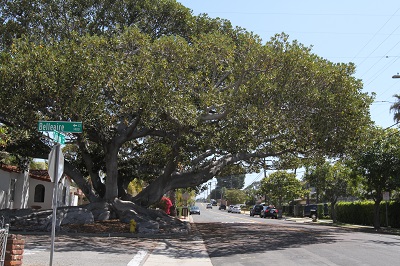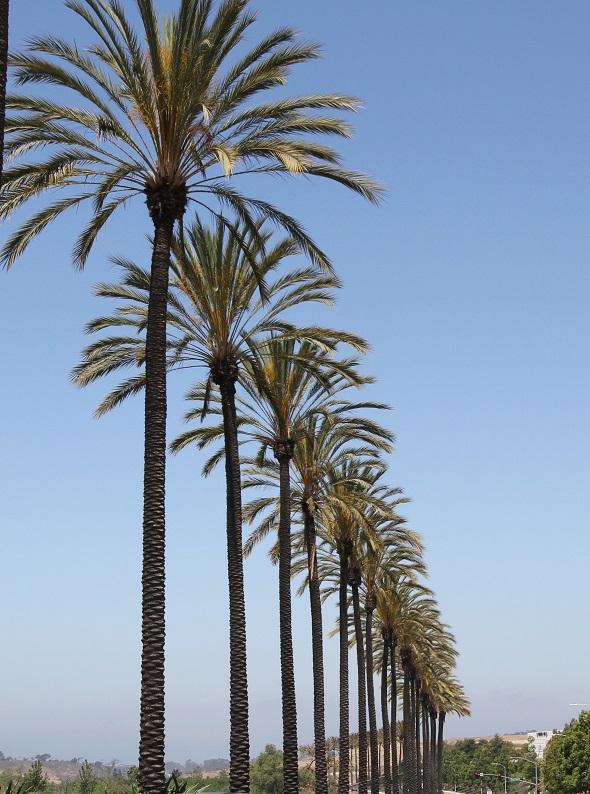|
by Kristi Hawthorne, Oceanside Living Magazine 2016 Trees are an important part of any city, enhancing it with beauty and adding color, providing needed shade, as well as providing a habitat for wildlife. In 1884, Oceanside’s Founder Andrew Jackson Myers, began planting “wattle and blue gum trees on the avenues in Oceanside”. These trees are more commonly known as acacia and eucalyptus. Other early popular tree varieties included cypress and pine, which after a few years became “a nuisance, damaging sewers, sidewalks and the streets.” Palm trees lined Hill Street (now Coast Highway) as early as the 1890s and as Oceanside developed, its citizens continued to plant trees along its streets and avenues. In 1896 the newspaper reported that 155 palms were planted along with 200 pepper trees, 175 cypress, 275 pines and 420 sugar gums.  The Moreton Bay Fig tree was planted by Archibald Cope in about 1935. Since it was first planted as a dry root twig at the corner of California and Bellaire Streets it has grown to a magnificent example of its species. The Moreton Bay Fig tree was planted by Archibald Cope in about 1935. Since it was first planted as a dry root twig at the corner of California and Bellaire Streets it has grown to a magnificent example of its species. Fruit trees, for obvious reasons were popular within the city and San Luis Rey Valley. While we think immediately of oranges and avocado trees, some of the earliest fruit trees also included lemon and olive. In fact, an early newspaper was entitled “The Oceanside Olive Leaf”. In 1917 William Mebach planted 63 black acacia trees on Topeka Street from Horne Street to Hill street. This may have been the beginning of planting certain types of trees exclusive to certain streets. When B. C. Beers developed his ocean view subdivision in 1924, on West Alberta and Leonard Streets, he named it Plumosa Heights, after the nearly 300 Cocos Plumosa palms that were planted there. Two years later H.C. Ellery planted pepper trees along his subdivision on Mesa Drive. The city announced in 1927 that an additional one thousand trees would be planted to further beautify the streets. Vernon Nuthall was hired as City Forester, who reported in 1928 that there were 2,891 trees in “improved parkways” or streets, with 991 new trees yet to be planted. Clementine Street featured over 200 Acacia Dealbata trees while Freeman, Fourth and Tremont Streets had over 400 Acacia Melanoxylon trees altogether. Ditmar and Michigan Streets were lined with 331 Live Oak trees. Tait, Topeka and Myers Street were planted in Scarlet Eucalyptus; Sixth Street with Monterey Pine Trees. Pittosporum Undulatum Trees were planted along First Street (now Seagaze) and Washington. Nevada Street was lined with Pine and Jacaranda. Carob trees were planted on Horne and Minnesota Streets. Other varieties included Camphor on Fifth Street and Casuarina Stricti on Missouri. Many of the trees in the downtown have been removed for street widening, sidewalk and/or repair. Different varieties of trees have been replanted over the decades but for the most part the original tree schematic has all but disappeared. However, many of those original trees are still standing, after nearly 90 years or more. While the iconic Palm still lines Coast Highway, Pacific Street and Mission Avenue, there is a push to recognize native trees such as the Coast Live Oak, the Torrey Pine, Western Redbud and the Sweet Bay. The Coast Live Oak is Official City Native Tree while the Gold Medallion Tree is the Official City Ornamental Tree. 3/28/2021 09:53:22 pm
So majestic! But some of those intersections are so unwalkable. Comments are closed.
|
Categories
All
Archives
December 2023
|
|
|
|
|


 RSS Feed
RSS Feed
